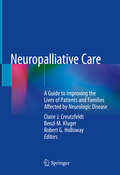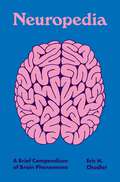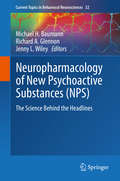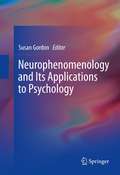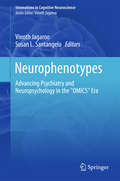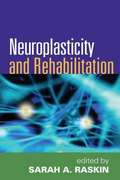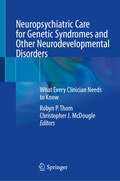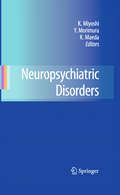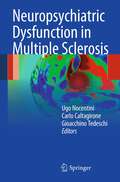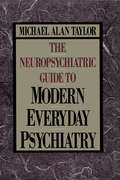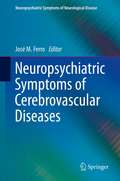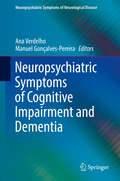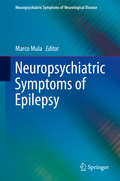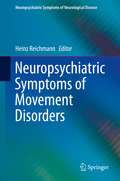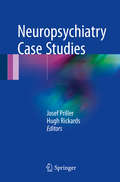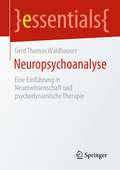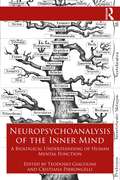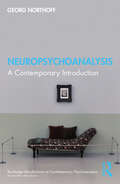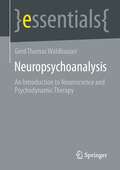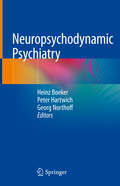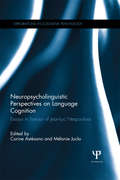- Table View
- List View
Neuronal Dynamics
by Wulfram Gerstner Werner M. Kistler Richard Naud Liam PaninskiWhat happens in our brain when we make a decision? What triggers a neuron to send out a signal? What is the neural code? This textbook for advanced undergraduate and beginning graduate students provides a thorough and up-to-date introduction to the fields of computational and theoretical neuroscience. It covers classical topics, including the Hodgkin-Huxley equations and Hopfield model, as well as modern developments in the field such as Generalized Linear Models and decision theory. Concepts are introduced using clear step-by-step explanations suitable for readers with only a basic knowledge of differential equations and probabilities, and are richly illustrated by figures and worked-out examples. End-of-chapter summaries and classroom-tested exercises make the book ideal for courses or for self-study. The authors also give pointers to the literature and an extensive bibliography, which will prove invaluable to readers interested in further study.
Neuronale Modellierung der Sprachverarbeitung und des Sprachlernens: Eine Einführung
by Bernd J. KrögerDieses Buch erläutert die Thematik der Produktion und Wahrnehmung gesprochener Sprache aus neurowissenschaftlicher Sicht. Nach der Darstellung der Grundlagen der Sprachverarbeitung und des Spracherwerbs wird dem Leser ein neurobiologisch basiertes und computerimplementiertes neuronales Simulationsmodell vorgestellt. Diese Einführung in die quantitative und computerimplementierbare Modellierung der Sprachverarbeitung und des Sprachlernens basiert auf einem naturwissenschaftlich orientierten Ansatz zur Beschreibung gesprochener Sprache. Dennoch wird weitgehend auf mathematische Beschreibungen verzichtet.Das Buch spricht Studierende und Wissenschaftler der Bereiche Neurowissenschaften, Informatik, Medizin, Psychologie und Linguistik an, die sich in das Gebiet der Sprachverarbeitung und des Spracherwerbs aus neurowissenschaftlicher Sicht einarbeiten möchten. Es richtet sich aber auch an Anwender, die sich mit der Entwicklung von Software zur Sprachverarbeitung befassen.
Neuropalliative Care: A Guide To Improving The Lives Of Patients And Families Affected By Neurologic Disease
by Claire J. Creutzfeldt Benzi M. Kluger Robert G. HollowayThis comprehensive guide thoroughly covers all aspects of neuropalliative care, from symptom-specific considerations, to improving communication between clinicians, patients and families. Neuropalliative Care: A Guide to Improving the Lives of Patients and Families Affected by Neurologic Disease addresses clinical considerations for diseases such as dementia, multiple sclerosis, and severe acute brain injury, as well discussing the other challenges facing palliative care patients that are not currently sufficiently met under current models of care. This includes methods of effective communication, supporting the caregiver, how to make difficult treatment decisions in the face of uncertainty, managing grief, guilt and anger, and treating the pain itself. Written by leaders in the field of neuropalliative care, this book is an exceptional, well-rounded resource of neuropalliative care, serving as a reference for all clinicians caring for patients with neurological disease and their families: neurologists and palliative care specialists, physicians, nurses, chaplains, social workers, as well as trainees in these areas.
Neuropedia: A Brief Compendium of Brain Phenomena (Pedia Books #12)
by Eric H. ChudlerA fun and fact-filled A–Z treasury for anyone with a head on their shouldersNeuropedia journeys into the mysteries and marvels of the three pounds of tissue between your ears—the brain. Eric Chudler takes you on a breathtaking tour of the nervous system with dozens of entries that explore the structure and function of the brain and cover topics such as the spinal cord and nerve cells, the methods of neuroscientific research, and the visionary scientists who have dedicated their lives to understanding what makes each of us who we are.The brain has fascinated and puzzled researchers, physicians, and philosophers for thousands of years and captivated us with each new discovery. This compendium of neuroscientific wonders is brimming with facts and insights, helping us to make sense of our current understanding of the nervous system while identifying the frontiers in our knowledge that remain unexplored. Chudler guides readers through a variety of rare and common neurological disorders such as alien hand disorder, Capgras syndrome, Alzheimer’s disease, Parkinson’s disease, and stroke, and discusses the latest brain-imaging methods used to diagnose them. He discusses neurochemicals, neurotoxins, and lifesaving drugs, and offers bold perspectives on human consciousness that enable us to better appreciate our place in nature.With marvelous illustrations by Kelly Chudler, Neuropedia is an informative and entertaining trip into the inner world of the brain.
Neuropharmacology of New Psychoactive Substances: The Science Behind the Headlines (Current Topics in Behavioral Neurosciences #32)
by Richard A. Glennon Michael H. Baumann Jenny L. WileyDesigner drugs, or new psychoactive substances (NPS), are synthetic chemicals that mimic the effects of classic drugs of abuse. There has been an alarming worldwide increase in the abuse of NPS in recent years. NPS are cheap, easy to obtain, and often legally available. In this volume, leading experts summarize the latest studies regarding the molecular mechanisms of action, behavioral effects, and adverse consequences of popular NPS. Specific chapters clarify the differences between various types of NPS, namely: stimulants, cannabinoids and hallucinogens. Thus, this volume broadens our understanding of NPS and provides insight into the rapidly evolving “new drug” phenomenon.
Neurophenomenology and Its Applications to Psychology
by Susan GordonThis book explores the meaning and import of neurophenomenology and the philosophy of enactive or embodied cognition for psychology. It introduces the psychologist to an experiential, non-reductive, holistic, theoretical, and practical framework that integrates the approaches of natural and human science to consciousness. In integrating phenomenology with cognitive science, neurophenomenology provides a bridge between the natural and human sciences that opens an interdisciplinary dialogue on the nature of awareness, the ontological primacy of experience, the perception of the observer, and the mind-brain relationship, which will shape the future of psychological theory, research, and practice.
Neurophenotypes
by Vinoth Jagaroo Susan L. SantangeloThis expansive text applies the latest knowledge of neural and cognitive biomarkers to the contemporary bioinformatics and "omics" landscape, and to neuropsychology and psychiatric research and practice. Focusing on neurophenotypes and endophenotypes, it updates concepts of neurocognitive and behavioral functioning, normal and disordered processes and structures, and their myriad relationships within the larger context of the nervous system. Specialized chapters delve into neural and cognitive gray areas that may be classified as neurophenotypes or cognitive endophenotypes, including face perception, reward deprivation, EEG data, and fear conditioning. These advances signal a new accuracy in neuroscience, from a more precise fit between data, tools, and models to more effective diagnosis, treatment, and policy. Among the topics covered: #65533; Brain and cognition in the "omics" era. #65533; Appraising circuit-centered neurophenotypes. #65533; Cognitive phenotypes and endophenotypes: concepts and criteria. #65533; The strategy and utility of the endophenotype approach to neurobehavioral function. #65533; Neural markers of errors as endophenotypes in neuropsychiatric disorders #65533; Implications for neuropsychology and psychiatry. Neurophenotypes and endophenotypes are critical discoveries in a developing field, and the analysis in Phenotypes spotlights their utility to neuropsychologists, neurologists, psychiatrists, and cognitive neuroscientists. This clarion work prepares research and clinical professionals for the world of technology- and science-based paradigms to come.
Neurophysiologic Biomarkers in Neuropsychiatric Disorders: Etiologic and Treatment Considerations (Advances in Neurobiology #40)
by Daniel C. Javitt James C. McPartlandThis book reviews neurophysiological biomarkers in neuropsychiatric disorders from the viewpoint of the 21st Century Cures Act, which encourages the use of biomarkers for a variety of purposes during drug development. It covers both traditional etiologic uses of biomarkers and the more recent Biomarkers, EndpointS, and other Tools (BEST) classification scheme used by the FDA, which permits biomarkers for purposes of susceptibility, diagnosis, monitoring, prognosis, pharmacodynamics/response, and safety. The first section of the book describes potential uses of neurophysiologic biomarkers. Subsequent sections focus on a wide range of conditions, including schizophrenia, autism spectrum disorder, Parkinson’s disease, and depression, as well as cross-diagnostic and translational uses, including monkey and rodent analogs. The purpose of the book is to help clinicians understand how neurophysiological biomarkers may be used to understand and manage clinical conditions; to help researchers to understand how biomarkers may be used translationally to test specific theories; and to help pharma investigators to understand how biomarkers can be used to accelerate treatment development.
Neurophysiology and Psychophysiology: Experimental and Clinical Applications (Psychology Revivals)
by G. C. Galbraith M. L. Kietzman E. DonchinOriginally published in 1988, in several respects this book is a tribute to the outstanding career of the late Donald B. Lindsley (1907-2003) who, over a span of more than 55 years, had contributed greatly to the development of research in the fields of neurophysiology, psychophysiology, and experimental psychology. The impetus for the book was a conference held at UCLA to honor Professor Lindsley for his numerous and significant contributions to psychology. The chapters of this book have been written by Professor Lindsley’s colleagues and co-workers, and by former students and postdoctoral fellows. The introductory chapter, written by Lindsley himself, tells of 2000 years of "pondering". The chapter is a discussion of the lengthy history of neurophysiology, psychophysiology, and behaviour. Many of the topics mentioned in this chapter are subsequently presented in the book as reports of ongoing research in the field.
Neuroplasticity and Rehabilitation
by Sarah RaskinBrain plasticity is the focus of a growing body of research with significant implications for neurorehabilitation. This state-of-the-art volume explores ways in which brain-injured individuals may be helped not only to compensate for their loss of cognitive abilities, but also possibly to restore those abilities. Expert contributors examine the extent to which damaged cortical regions can actually recover and resume previous functions, as well as how intact regions are recruited to take on tasks once mediated by the damaged region. Evidence-based rehabilitation approaches are reviewed for a range of impairments and clinical populations, including both children and adults.
Neuropsychiatric Care for Genetic Syndromes and Other Neurodevelopmental Disorders: What Every Clinician Needs to Know
by Christopher J. McDougle Robyn P. ThomChildren and adults with developmental disabilities are at increased risk for experiencing behavioral problems and psychiatric comorbidities compared to the general population and several neurodevelopmental disorders are associated with certain neuropsychiatric conditions. Because of language and cognitive differences, the clinical presentation of these conditions can differ from what is seen in the general population. Furthermore, research on treatment approaches for psychiatric comorbidities in these populations is extremely limited and evidence-based treatment guidelines do not exist. This book is a collection of neurodevelopmental disorders that are frequently associated with relatively distinct and common psychiatric co-morbidities across the lifespan. Each chapter addresses a different neurodevelopmental disorder by providing an overview, symptoms of common psychiatric co-morbidities, assessment strategies, psychosocial and biological treatments, and common medical co-morbidities the clinician needs to have basic knowledge of with regards to choosing safe and appropriate pharmacotherapy. Given how relatively rare many of these syndromes are, the practicing clinician generally does not encounter a sufficient number of cases during training or clinical practice to develop comfort and expertise in each of them. Furthermore, there are no easy to access evidence-based treatment guidelines. This succinct and practical resource fills a needed gap for an overview of the most common neurodevelopmental disorders in a single resource with a clinical expert’s approach to diagnosis and management.
Neuropsychiatric Disorders
by Kiyoshi Maeda Yasushi Morimura Koho MiyoshiAround the world societies are facing growing aging populations with the concomitant increase in neuropsychiatric disorders. Neuropsychiatric disorders are organic brain diseases with psychiatric symptoms, as in Alzheimer's and Parkinson's diseases, that cause cognitive impairment, including dementia, amnesic syndrome, and personality-behavioral changes. As a clinical science, neuropsychiatry aims to explore the complex interrelationship between behavior and brain function from a variety of perspectives, including those of psychology, neurology, and psychiatry. This concise and updated monograph comprises the latest findings in the field and includes chapters on delusional symptoms, mood disorders and neurotic symptoms, cognitive impairment, behavioral and personality changes, and recently, cerebral alterations revealed in PTSD patients and in endogenous psychoses through neuroimaging and neuropathology. These findings will certainly widen the realm of neuropsychiatry going forward and will prove of great value to specialists as well as to academics and trainees in neurology, psychiatry, neuropsychology, neuroradiology, neuropathology, neurophysiology, neurochemistry, and clinical genetics. Ultimately, neuropsychiatry aims to prevent and reduce the suffering of individuals with the psychiatric symptoms of cerebral disorders.
Neuropsychiatric Dysfunction in Multiple Sclerosis
by Gioacchino Tedeschi Ugo Nocentini Carlo CaltagironeThis book provides comprehensive and up-to-date information on the neuropsychiatric disturbances that may be experienced by patients with multiple sclerosis. The first section is designed primarily to describe the general clinical aspects of multiple sclerosis, from epidemiology to assessment tools. The role of neuroimaging and especially MRI is then explained, and treatment approaches and rehabilitation strategies are described. The core section of the volume is the second, in which the various forms of neuropsychiatric dysfunction are considered in depth. Especially, detailed attention is devoted to depression, but the other main categories of disturbance are also described and discussed. The final section addresses cognitive dysfunctions since they represent some of the worst events that patients with multiple sclerosis can suffer and are intimately related to neuropsychiatric dysfunction.
Neuropsychiatric Guide to Modern Everyday Psychiatry
by Michael Alan TaylorPresents a new view of psychiatry, blending traditional biologic, neuro- and descriptive psychiatry into a broad neuropsychiatric approach to diagnosis and treatment. Incorporating step-by-step assessment and management strategies, Taylor provides a practical guide for clinical care.
Neuropsychiatric Symptoms of Cerebrovascular Diseases
by José M. FerroNeuropsychiatric Symptoms of Cerebrovascular Diseases is an up-to-date, comprehensive review of the neuropsychiatry of stroke, by active authorities in the field, with an emphasis on diagnostic and management issues. Neuropsychiatric Symptoms of Cerebrovascular Diseases includes critical appraisal of the methodological aspects and limitations of the current research on the neuropsychiatry of stroke and on unanswered questions/controversies. Pharmacological aspects of management are discussed, to provide robust information on drug dosages, side effects and interaction, in order to enable the reader to manage these patients more safely. Illustrative cases provide real life scenarios that are clinically relevant and engaging to read. Neuropsychiatric Symptoms of Cerebrovascular Diseases is aimed at neurologists, stroke physicians and psychiatrists, and will also be of interest to intensive care doctors, psychologists ad neuropsychologists, research and specialist nurses, clinical researchers and methodologists.
Neuropsychiatric Symptoms of Cognitive Impairment and Dementia
by Ana Verdelho Manuel Gonçalves-PereiraThis book is an up-to-date, comprehensive review of the neuropsychiatry of different types of cognitive impairment by active authorities in the field. There is an emphasis on diagnostic and management issues. Cognitive impairment both with and without criteria for dementia is covered. A critical appraisal of the methodological aspects and limitations of the current research on the neuropsychiatry of cognitive impairment and dementia is included. Unanswered questions and controversies are addressed. Non-pharmacological and pharmacological aspects of management are discussed, to provide robust information on drug dosages, side effects and interaction, in order to enable the reader to manage these patients more safely. Illustrative cases provide real life scenarios that are clinically relevant and engaging to read. Neuropsychiatric Symptoms of Cognitive Impairment and Dementia is aimed at neurologists, psychiatrists, gerontologists, and general physicians. It will also be of interest to intensive care doctors, psychologists and neuropsychologists, research and specialist nurses, clinical researchers and methodologists.
Neuropsychiatric Symptoms of Epilepsy
by Marco MulaThis book is an up-to-date, comprehensive review of the neuropsychiatry of epilepsy, by active authorities in the field, with an emphasis on clinical and management issues. A critical appraisal of the methodology and limitations of current research on the neuropsychiatry of epilepsy is provided, and unanswered questions and controversies are addressed. Pharmacological aspects of management are also discussed in order to enable the reader to manage these patients more safely. Neuropsychiatric Symptoms of Epilepsy is aimed at neurologists, epileptologists, psychiatrists and neuropsychiatrists, and will also be of interest to psychologists and neuropsychologists, research and specialist nurses, clinical researchers and methodologists.
Neuropsychiatric Symptoms of Movement Disorders
by Heinz ReichmannThis is an up-to-date, comprehensive review of the neuropsychiatry of patients with movement disorders, i. e. Parkinson's disease, Huntington's disease, dystonia and others, by active authorities in the field, with an emphasis on diagnostic and management issues. This book includes critical appraisal of the methodological aspects and limitations of the current research on the neuropsychiatry of movement disorders and on unanswered questions/controversies. Symptomatology and pharmacological aspects of management are discussed, to provide robust information on drug dosages, side effects and interaction, in order to enable the reader to manage these patients more safely. Illustrative cases provide real life scenarios that are clinically relevant and engaging to read. Neuropsychiatric Symptoms of Movement Disorders is aimed at neurologists, movement disorder specialists and psychiatrists and will also be of interest to intensive care doctors, psychologists and neuropsychologists, research and specialist nurses, clinical researchers and methodologists.
Neuropsychiatry Case Studies
by Josef Priller Hugh RickardsThis book comprises succinct, accessible clinical cases in neuropsychiatry. Each clinical case has a specific and practical learning point, concerned with assessment, diagnosis, treatment or general approach. Each case models clinical reasoning and shows how the 'puzzle' in the case changed the future practice of the author. Neuropsychiatry Case Studies is divided into sections relating to specific areas of neuropsychiatry, including dementias, movement disorders, autoimmune encephalopathies and epilepsy, amongst others. This book is aimed at trainee doctors in neurology and psychiatry and will also be of interest to fully trained doctors, nurses, psychologists and other allied health professionals working in this area.
Neuropsychoanalyse: Eine Einführung in Neurowissenschaft und psychodynamische Therapie (essentials)
by Gerd Thomas WaldhauserNeurowissenschaft und Psychoanalyse erscheinen zunächst als zwei grundsätzlich verschiedene, unvereinbare Zugänge zum menschlichen Erleben und Verhalten. Allerdings gab es schon seit Beginn der Entwicklung der Psychoanalyse immer wieder Bestrebungen, psychoanalytische Konzepte und Prozesse neurowissenschaftlich zu begründen. Auf der anderen Seite liefert die Psychoanalyse ein umfassendes Modell der menschlichen Psyche in all ihrer Komplexität und Dynamik, welches helfen könnte, die vielfältigen und häufig sehr spezialisierten Ergebnisse der modernen Hirnforschung in ihrer Gesamtheit zu verstehen. Das vorliegende Buch fasst den momentanen Stand der Forschung in diesem Schnittbereich zwischen Tiefenpsychologie und Hirnforschung zusammen und arbeitet heraus, wie sowohl Praktiker als auch Grundlagenforscher von einem fruchtbaren Austausch zwischen den beiden Disziplinen profitieren können.
Neuropsychoanalysis of the Inner Mind: A Biological Understanding of Human Mental Function
by Teodosio GiacoliniThis comprehensive and well-curated collection explores how neuroscience can be integrated into psychoanalytic thinking and practice, reexamining the biological science within psychological (sexuality, pleasure, and dreams), social (pornography), and psychopathological (learning and attention disorders, anhedonia) phenomena relevant to therapists and analysts. Neuropsychoanalysis of the Inner Mind stands out for its focus on the emotional-motivational aspects of the mind, which are considered through the lenses of affective neuroscience, psychoanalytic theory and neuropsychoanalysis, and is important reading for scholars and psychologists interested in the topics originally addressed by Freud in his 1895 publication Project for a Scientific Psychology.
Neuropsychoanalysis: A Contemporary Introduction (Routledge Introductions to Contemporary Psychoanalysis)
by Georg NorthoffGeorg Northoff presents the first introduction to neuropsychoanalysis and the search for a brain-based understanding and explanation of our psyche and its psychodynamic features. This book covers the key features of psychodynamics, including the concepts of self, narcissism, defence mechanisms, unconsciousness/consciousness, attachment and trauma, energy/cathexis, and depression/schizophrenia. After reviewing past and current state-of-the-art models and their limitations, Northoff uniquely links these psychodynamic features to temporal and spatial features in the brain (and body). The key element in connecting brain and mind is dynamic, the pattern of change over time: from brain dynamic to psychodynamic - dynamic is thus shared by brain and psyche as their "common currency". This spatiotemporal approach offers novel and sometimes surprising insights into the elusive connection of brain and mind. Ultimately, this carries important clinico-therapeutic implications for psychodynamic psychotherapy in a spatiotemporal sense, such as through spatiotemporal psychotherapy. This accessible volume will be of great interest to neuroscientists, neuropsychoanalysts, psychologists, psychoanalysts, and anyone interested in the brain-mind connection. Additional material for the present book including figures and tables as well as short talks about each chapter can be found on this website (www.georgnorthoff.com) including the author’s YouTube channel.
Neuropsychoanalysis: An Introduction to Neuroscience and Psychodynamic Therapy (essentials)
by Gerd Thomas WaldhauserNeuroscience and psychoanalysis initially appear as two fundamentally different, incompatible approaches to human experience and behavior. However, from the very beginning of the development of psychoanalysis, there have been repeated efforts to ground psychoanalytic concepts and processes in neuroscience. On the other hand, psychoanalysis provides a comprehensive model of the human psyche in all its complexity and dynamics, which could help to understand the diverse and often highly specialized findings of modern brain research in their entirety. This book summarizes the current state of research in this area of intersection between depth psychology and brain research and elaborates how both practitioners and basic researchers can benefit from a fruitful exchange between the two disciplines.
Neuropsychodynamic Psychiatry
by Georg Northoff Peter Hartwich Heinz BoekerThis book presents a comprehensive neuropsychodynamic strategy for treating psychiatric disorders. Rather than pursuing an exclusively biological, psychological, or psychodynamic approach, it offers a methodology that links all three aspects in a unifying, integrative model. Central to this approach is the view of the brain as a bio-psychosocial organ in a neuro-ecological model, rather than the purely neuronal model often presupposed in current neuroscience and psychiatry. Moreover, the book views psychopathological symptoms as spatiotemporal disorders of the altered spatiotemporal structure spanning the brain and its surrounding world. The relation between one of the core symptoms and altered neuronal activity calls for the development of integrated, circular neuropsychodynamic models of psychopathological symptoms in severe psychiatric disorders and their treatment.
Neuropsycholinguistic Perspectives on Language Cognition: Essays in honour of Jean-Luc Nespoulous (Explorations in Cognitive Psychology)
by Corine Astesano Mélanie JuclaThis book brings together experts from the fields of linguistics, psychology and neuroscience to explore how a multidisciplinary approach can impact on research into the neurocognition of language. International contributors present cutting-edge research from cognitive and developmental psychology, neuropsychology, psycholinguistics and computer science, and discuss how this contributes to neuropsycholinguistics, a term coined by Jean-Luc Nespoulous, to whom this book is dedicated.Chapters illustrate how researchers with different methods and theoretical backgrounds can contribute to a unified vision of the study of language cognition. Reinterpreting neuropsycholinguistics through the lens of each research field, the book demonstrates important attempts to adopt a comprehensive view of speech and language pathology.Divided into three sections the book covers: <P><P> <li>linguistic mechanisms and the architecture of language <li>the relationship between language and other cognitive processes <li>the assessment of speech and language disabilities and compensatory mechanisms. <P><P>Neuropsycholinguistic Perspectives on Language Cognition presents a unique contribution to cognitive science and language science, from linguistics to neuroscience. It will interest academics and scholars in the field, as well as medical researchers, psychologists, and speech and language therapists.


